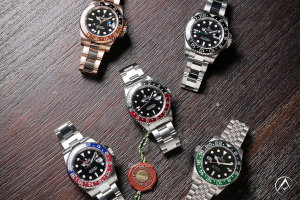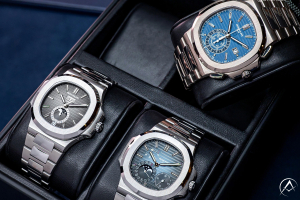
Haunted houses riddled with ghosts and items moving on their own accord seem plausible, but a haunted clock seems a bit unusual. People have told stories about broken watches or clocks that ticked when someone passed. Whether or not they seem believable, to some, the stories are comforting and oftentimes amusing. However, with Halloween just around the corner, the curse of the Prague Clock was one that caught my attention.
The Prague Astronomical Clock, also known as the Orloj, stands in The Czech Republic. While Prague is the perfect city for any architectural buff and bohemian-style lover, the clock is the best-known tourist attraction in the largest city of the Czech Republic. It is the third-oldest astronomical clock in the world and the oldest clock still in operation.

The Prague Astronomical Clock, 2019.
The medieval device, covered with Gothic-style details, is famous for its two intricate astronomical and calendar dials. Additionally, it has gained fame for its massive size, measuring approximately 9.8 feet in diameter. The crowds are known to gather every hour near the south wall of the Old Town Hall in the Old Town Square to see the clock’s animated figures.
The astronomical dial is a form of mechanical astrolabe, a device used in medieval astronomy. The blue and orange background trimmed with gold represents the earth and sky at different times of the day.
Designed before people knew that it was the Earth that rotates around the sun rather than the other way around, the four phases of the day have the Earth surrounded by orange, black, green, and blue colors. Now, people consider the Orloj a medieval planetarium because it accurately displays the current state of the universe.

Top dial of the Prague Clock.
Its four moving parts make it a marvel of mechanical engineering. The outer rotating ring displays Babylonian time, Old Bohemian time, German time, and Sidereal time. The inner ring displays the current signs of the zodiac.
In addition, there is a sun and moon hand. The sun hand shows the position of the sun on the ecliptic, which is the Earth’s orbit around the sun. It also displays the time of the sunrise and sunset. The moon hand exhibits the moon ecliptic, as well as the current phase of the moon.

Bottom dial of the Prague Clock.
Located below the clock, the calendar dial displays the day of the month (represented by medallions). In addition, it displays the days of the week and even holidays. Alongside the calendar's dial are statues of four virtues: a chronicler, an angel, an astronomer, and a philosopher. When the clock reaches a new hour, the skeleton rings a bell and inverts his hourglass.
Above the astronomical dial, the 12 Apostles peak through two windows before passing by. Upon completion of their 30-second routine, the golden rooster figurine crows. The clock has been running for over 600 years, and it's one of the world's most fascinating timepieces.
The Creation & The Curse
In the 14th and 15th centuries, King Charles IV had a vision for Prague to be redeveloped as one of Europe’s most beautiful cities. Independent artists left their marks on the city, and they built the Old Town Hall Tower.
Contributing to the redesign of the city were clockmaker Mikuláš of Kadaň and astronomer/scientist Jan Šindel. The councilors of Prague chose them to construct a machine that functioned as more than just a timekeeper. The infamous Prague Clock was completed in 1410.

The Old Town Hall, 2019.
According to legend, Kadaň’s work was considered such a masterpiece, that many nations approached him to create an equally magnificent astronomical clock. Jealous and scared that Kadaň would build a bigger and more beautiful clock, the council acted quickly. To ensure no other country would ever have a clock like theirs, they blinded Kadaň’s eyes with a piece of iron. Enraged, Kadaň sought revenge.
Some stories say that the clockmaker threw himself into the mechanics of the clock to stop it from ever working. Other stories say he destroyed the mechanism until it was broken beyond repair.
Regardless of which story you believe, the attempt at destroying his work cursed the clock. Whoever attempted to fix the clock would either go insane or die. It took more than a century before another clockmaker plucked up the courage to fix the colossal timepiece once more.
Restorations
Unafraid of the curse, Jan Růže modified the clock by adding the calendar dial, Gothic figurines, and columns in 1490. In 1552, clockmaker Jan Táborský spent 20 years repairing the clock and mechanizing the 4 virtues. Between 1629 and 1659, moving wooden figurines were added.
Before the 12 Apostles, the four figurines represented the greatest worries of Prague’s citizens at the time. These were Greed, Vanity, Pagan Invasion, and Death (the skeleton figurine). When the skeleton rings the bell every hour, the other figures shake their heads from side to side, declaring their unreadiness.

The skeleton on the Prague Clock.
Legend says that whenever the astronomical clock stopped running for an extended period, the skeleton would nod his head in confirmation that the Czech nation would suffer bad times until the clock was fixed. In one story, the only way to fend off the evil was to await for the clock to move again and have a boy, born on New Year’s night, run out of the Týn Church across the whole square to the Town Hall before the last strike of the clock.
Most believers of the legend, however, see the skeleton as a sign of hope. Two little windows overlook the clock, which used to lead to a jail that imprisoned the aristocrats. When one knight was pardoned, the people of Prague believed it was due to the skeleton sitting outside the knight’s window.
Between 1787 and 1861, they almost sold the clock as scraps because they had no money for repairs. Luckily, the ‘curse’ didn’t last long, and restoration began in 1865; this restoration saw the wooden figures become Apostles. They added a golden figure of a crowing rooster during the next major repair in 1882. Whistles and bells created the crowing sound.

Inside of the Astronomical Clock; the 12 Apostles.
True tragedy struck the Prague Clock during the Prague Uprising in May 1945. The Nazis bombarded the Old Town Hall. The clock suffered severe damage, and the fire burned away many of the figures, including the calendar dial. The clock stood motionless for 3 years until Vojtěch Sucharda repaired the mechanism and the wooden Apostles.
In 1957, they added Old Bohemian time to the clock. The Prague City Museum moved the original sculptures to ensure their safety in 1976 and replaced them with copies. They restored the lower calendar ring in 2005. A net covered the wooden statues to keep pigeons away.
To celebrate the 600th Anniversary, a light show commenced on October 9, 2010, on the clock face. The projectors showcased animated videos of the clock being built, torn down, and rebuilt. They also showed the internal mechanisms, animated figurines, and the clock’s history.
They renovated the Old Town Tower in 2018. They replaced the electric clock mechanism from the 1860s with the one that had been functioning since 1948. They took down the clock and replaced it with an LED screen. That is until they reconstructed the clock to celebrate the 100th Anniversary of Czechoslovakia.
Controversy
In 2022, a local heritage group observed a radical alteration in the reproduction of the Orloj. The figurines changed in appearance, age, skin tone, and gender. A complaint was registered with the Ministry of Culture alleging that painter Stanislav Jirčík deviated from the original in an over $2 million restoration in 2018.
Before and after details from the astronomical calendar.
The Prague City Council’s Deputy Mayor for Transport and Heritage suggested the city needed to commission a replacement. As of today, it is unknown whether Mayor Adam Scheinherr has spoken with Jirčík to find out his intentions. We still don't know his inspiration or if he studied the original work of Josef Mánes before beginning the restoration. While some believe Jirčík did not have the task of restoring Mánes original work but create a new copy, many believe the artist painted his friends into the work as a joke.
Before and after details from the astronomical calendar.
Today
Many visitors come for the hourly show of the wooden figures. You can also enter the Old Town Hall to view the inner mechanics of the Astronomical Clock for a guided tour. For 250 CZK or 10 EUR per person (about $10), you will have access to the Old Town Hall and the tower’s observation deck. You can also walk inside each of the halls’ structure and the Romanesque underground that used to serve as a jail.
The clock tower, which offers beautiful views of Prague, is open daily until 10 PM. The Old Town Hall is primarily used for ceremonies and events, aside from tours.
The Orloj has had many caretakers over the years, ensuring the city of Prague never suffers. For the past ten years, clock master Petr Skala has overseen renovations. He's also in charge of replacing the modern gears with ones that are closer to the original design.
So far, none of the caretakers have died or gone mad because of the clock…that is known. What do you believe?

 By
By 





